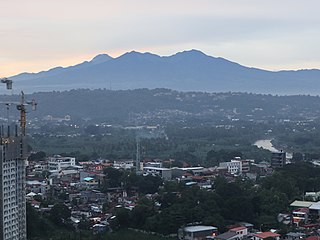
Mount Apo is the highest mountain peak in the Philippines, with an elevation of 2,954 meters (9,692 ft) above sea level. A large solfataric, dormant stratovolcano, it is part of the Apo-Talomo Mountain Range of Mindanao island. Apo is situated on the tripartite border of Davao City, Davao del Sur, and Cotabato; its peak is visible from Davao City 45 kilometers (28 mi) to the northeast, Digos 25 kilometers (16 mi) to the southeast, and Kidapawan 20 kilometers (12 mi) to the west. Apo is a protected area and is the centerpiece of Mount Apo Natural Park.

Davao del Sur, officially the Province of Davao del Sur, is a province in the Philippines located in the Davao Region in Mindanao. Its capital is Digos. Davao City is the largest city in terms of area and population within the province's jurisdiction, yet it is administratively independent from the province; as such, Davao City is only grouped for geographical and statistical purposes and serves as the regional center of Davao Region.

Davao City, officially the City of Davao, is a highly urbanized city in the Davao Region, Philippines. The city has a total land area of 2,443.61 km2 (943.48 sq mi), making it the largest city in the Philippines in terms of land area. It is the third-most populous city in the Philippines after Quezon City and Manila respectively, and the most populous city in Mindanao, in Davao Region, and outside of Metro Manila. According to the 2020 census, it has a population of 1,776,949 people.

Santa Cruz, officially the Municipality of Santa Cruz, is a 1st class municipality in the province of Davao del Sur, Philippines. According to the 2020 census, it has a population of 101,125 people.

The Lumad are a group of Austronesian indigenous peoples in the southern Philippines. It is a Cebuano term meaning "native" or "indigenous". The term is short for Katawhang Lumad, the autonym officially adopted by the delegates of the Lumad Mindanao Peoples Federation (LMPF) founding assembly on 26 June 1986 at the Guadalupe Formation Center, Balindog, Kidapawan, Cotabato. Usage of the term was accepted in Philippine jurisprudence when President Corazon Aquino signed into law Republic Act 6734, where the word was used in Art. XIII sec. 8(2) to distinguish Lumad ethnic communities from the islands of Mindanao.
Cotabato Manobo is a Manobo language spoken in Mindanao, the Philippines. Dialects include Tasaday and Blit.
The Tagbanwa are an ethnic group of Palawan, Philippines.
Sangir, also known as Sangihé, Sangi, Sangil, or Sangih, is an Austronesian language spoken on the islands linking northern Sulawesi, Indonesia, with Mindanao, Philippines by the Sangir people. It belongs to the Philippine group within the Austronesian language family.

The Manobo languages are a group of languages spoken in the Philippines. Their speakers are primarily located around Northern Mindanao, Central Mindanao and Caraga regions where they are natively spoken. Some outlying groups make Manobo geographically discontiguous as other speakers can be located as far as the southern peninsula of Davao Oriental, most of Davao Occidental and coastal areas of Sultan Kudarat. The Kagayanen speakers are the most extremely remote and can be found in certain portions of Palawan.
The Sangiric languages are a subgroup of the Austronesian languages spoken in North Sulawesi, Indonesia and several small islands to the north which belong to the Philippines. They are classified as a branch of the Philippine subgroup.
Tboli, also Tau Bilil, Tau Bulul or Tagabilil, is an Austronesian language spoken in the southern Philippine island of Mindanao, mainly in the province of South Cotabato but also in the neighboring provinces of Sultan Kudarat and Sarangani. According to the Philippine Census from 2000, close to 100,000 Filipinos identified T'boli or Tagabili as their native language.
Blaan, also known as Bla'an, is an Austronesian language of the southern Philippines spoken by an indigenous ethnic group of the same name who inhabited many areas of Soccksargen and Davao Occidental.
Kayan is a dialect cluster spoken by the Kayan people of Borneo. It is a cluster of closely related dialects with limited mutual intelligibility, and is itself part of the Kayan-Murik group of Austronesian languages.
Davaoeño (Dabawenyo) is a language of the Davao Region of Mindanao in the Philippines. According to Zorc (1977), it is a native Mansakan language influenced by Cebuano and Tagalog. Traditionally, it was the principal language of the Davaoeño people, but it is no longer spoken in Davao City as speakers have shifted to a local dialect of the Cebuano language, called Davaoeño Cebuano.
Kalagan is an Austronesian dialect cluster of the Davao Region of Mindanao in the Philippines. It is also spoken in a few parts of Caraga, still in Mindanao.
Agusan is a Manobo language of northeastern Mindanao in the Philippines.
Mandaya is an Austronesian language of Mindanao in the Philippines. It may be intelligible with Mansaka.
Klata is an Austronesian language of the southern Philippines. It is spoken on the eastern slopes of Mount Apo in Davao del Sur Province, as well as in Davao City (Ethnologue) in an area stretching from Catalunan to Calinan.
Tarangan is one of the Aru languages, spoken by inhabitants of the Aru Islands in eastern Indonesia. There are two varieties of Tarangan: East and West Tarangan. These varieties are divergent, perhaps no closer than they are to Manombai, also spoken in the Arus. West Tarangan is a trade language of the southern islands.
The Bagobo language can refer to either of the following Austronesian languages spoken in Mindanao, Philippines:






